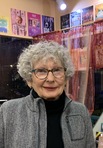Judith Works's Blog, page 11
July 27, 2012
THE VILLA FARNESE
Low clouds and mist enveloped Rome. It was cold. Even worse, the city was in chaos with demonstrations by flag-waving groups loudly protesting against the construction of a high-speed rail line in the north of Italy. Most of the demonstraters were dressed in jeans and sweaters but a group looking like monks with brown robes were standing around with cigarettes stuck in the middle of their mouths while waiting for their marching orders. Stores were shuttered and transit was tied in knots. We, my daughter and two friends, wound our way through back streets to reach the Via Cassia which would lead us to our destination: the late Renaissance-era Villa Farnese, famed for its frescoes and gardens – and we hoped quiet, sun and a good lunch.
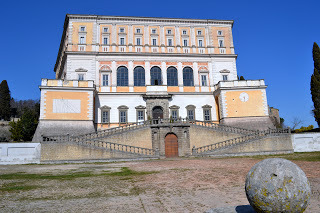
We headed north through the usual depressing detritus of suburbia, shopping malls and outlet stores until we reached the real countryside set with groves of filbert and olive trees along with a few vineyards. Turning this way and that we came to the small town of Caprarola, the site of the magnificent Villa Farnese built for Cardinal Alessandro Farnese between 1559 to 1575. The sun suddenly appeared to highlight a pentagon-shaped building rising five stories above a long flight of terraced steps set at the top on a hill dominating the town.
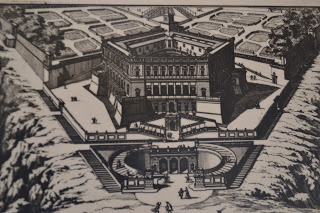 The Farneses knew how to live in style. Their Palazzo Farnese in Rome is now the location of the magnificently-decorated French Embassy near Campo di Fiori and the Villa Farnesina in Trastevere hosts a science academy and print collection. The villa we were visiting was a country house built by Cardinal Alessandro Farnese, grandson of Pope Paul III, over a partially constructed fortress begun by his ancestor in 1504.
The Farneses knew how to live in style. Their Palazzo Farnese in Rome is now the location of the magnificently-decorated French Embassy near Campo di Fiori and the Villa Farnesina in Trastevere hosts a science academy and print collection. The villa we were visiting was a country house built by Cardinal Alessandro Farnese, grandson of Pope Paul III, over a partially constructed fortress begun by his ancestor in 1504. After we each enjoyed a restorative cappuccino and cornetto the gigantic sundial on a south wall told us that it was time to start our tour of the interior, the 44-acre park, and the Renaissance garden crowning the hill. We joined a group of Italians out on a sunny spring day trip like us. Room after frescoed room conveyed the power and the glory of the Farnese clan.
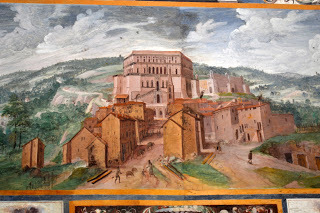
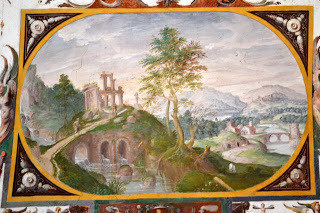 One room had romantic depictions of the towns and castles owned by the family;
One room had romantic depictions of the towns and castles owned by the family;another was called the Room of Farnese Deeds. Deeds, and there were a lot of them, were interesting but the Room of the World Map was the prize. The entire known world as it was in 1574 was depicted, some accurate and some wildly wrong.
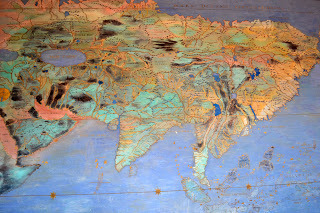
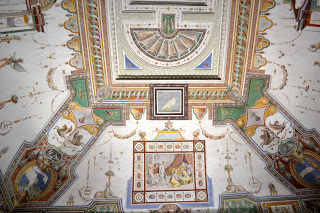
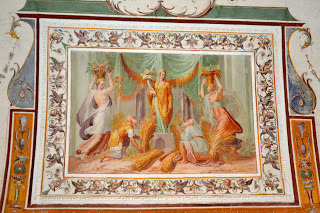 I was in fresco heaven with every wall and ceiling covered in disporting gods and goddesses alongwith flora, fauna and the family. Too much to possibly take in at one go.
I was in fresco heaven with every wall and ceiling covered in disporting gods and goddesses alongwith flora, fauna and the family. Too much to possibly take in at one go.
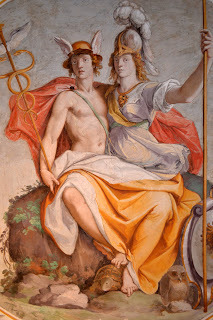
As we descended the glorious spiral staircase to cross the moat into the gardens I noticed a woman staring at me intently. Curious, I stared back, wondering why she was so interested. Was my fly unzipped? Then she said in English: “I know you, you worked at the United Nations in the ‘80s. Your name is Judith.”
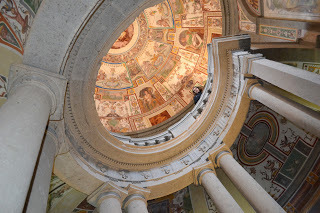 She was correct but how she remembered me I could not fathom. We chatted a few minutes before she turned back to her companions. Her parting words were, “How strange – this is the first time I have ever been to this villa.” Strange indeed.
She was correct but how she remembered me I could not fathom. We chatted a few minutes before she turned back to her companions. Her parting words were, “How strange – this is the first time I have ever been to this villa.” Strange indeed.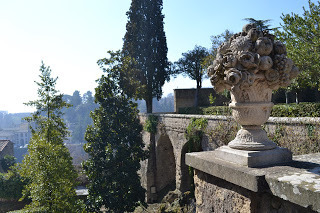 We crossed the drawbridge into the warm sunshine, a pleasure after the cold and damp interior where the fireplaces seemed too few and only hooks at the top of the walls remained to hang the long-gone tapestries used to help warm the enormous high-ceilinged rooms.
We crossed the drawbridge into the warm sunshine, a pleasure after the cold and damp interior where the fireplaces seemed too few and only hooks at the top of the walls remained to hang the long-gone tapestries used to help warm the enormous high-ceilinged rooms.
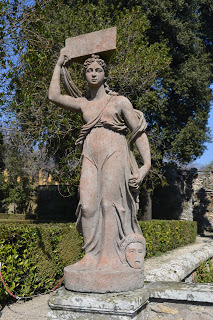
The bridge took us to a parterre garden made of box topiary and decorated with fountains, and then uphill through a park of chestnut trees. Wild crocus blooms carpeted the ground.
At the top we ascended the stairs flanked by a catena d’acqua, a staircase with water running down the side, to arrive at the casino – a summerhouse now belonging to the President of Italy. A delightful perk of office.
The adjacent garden is lined by stone herms (Roman boundary markers) and ancient dark cypresses set against the blue sky.
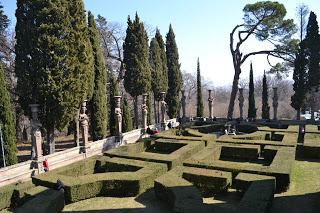
The casino has terraces for al fresco dining which reminded us that it was lunch time. When our tour was complete we asked about restaurants and were directed to Tratorria del Cimino. The menu was posted outside: carpaccio with funghi porcini, fried artichokes, homemade pastas and gnocchi, grilled and oven-roasted meats.
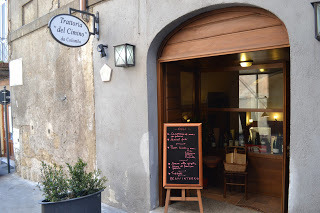
We opened the door and were welcomed by an agreeable host who brought bruschetta and local wine while we studied the menu. It was all tempting. I settled on the fettuccini followed by roast pork with rosemary potatoes. Biscotti and another cookie, rich with local filberts, for dessert arrived unbidden. With wine and coffee finished and our goal of peace, sun and good food met, it was time to head back to Rome. All was quiet, the demonstration was finished for the day and the sun was out. Our hotel terrace beckoned.
Ah – the never-ending delights of Italy.
Note: A version of this article appeared earlier on the site Sharing Travel Experiences, www.sharingtravelexperiences.com.
Published on July 27, 2012 10:32
July 8, 2012
FIFTY SHADES OF GREY - AND GREEN
We were in Belfast, Northern Ireland and wanted to see a bit of the countryside. The Ard Peninsula seemed to be a good idea. It was a good idea until we were well on our way. It started to rain, then it rained harder, then the rain came down in buckets. We continued anyway along the grey windblown Strangford Lough, an arm of the Irish Sea, toward our main goal: Grey Abbey. The complex contains the remains of a Cistercian abbey and outbuildings founded in 1193 by Affreca, the pious wife of a nobleman, in thanks for surviving a dangerous sea passage. The monastery was dissolved in 1541 by Henry VIII and destroyed in 1572 during Elizabethan times. Although the abbey itself was partially rebuilt in the 17th century and used as a church until 1778 nothing except some gravestones now suggest that it had been touched since put to the torch and sacked in the 1500s.
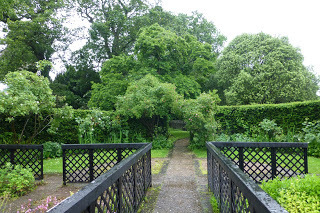 The ruins, set in an extensive greensward, stand open to the weather with the leafy graveyard to one side – a perfect location to visit on a rainy day if one wants to contemplate the passage of time. To enter the grounds we strolled through a reproduction of a medieval physic garden filled with the type of plants the monks would have used for themselves and the surrounding community. The industrious monks were the equivalent of our pharmaceutical companies, cultivating plants that were said to cure many common ailments – a catalogue of the unending miseries of medieval life and a few of our own.
The ruins, set in an extensive greensward, stand open to the weather with the leafy graveyard to one side – a perfect location to visit on a rainy day if one wants to contemplate the passage of time. To enter the grounds we strolled through a reproduction of a medieval physic garden filled with the type of plants the monks would have used for themselves and the surrounding community. The industrious monks were the equivalent of our pharmaceutical companies, cultivating plants that were said to cure many common ailments – a catalogue of the unending miseries of medieval life and a few of our own.Rosemary for aches, bad heart, worms in the teeth and as a digestive; Fennel for indigestion, bladder stones and as a diuretic; Comfrey to knit bones; Stavesacre to get rid of head lice; Herb Bennet to ward off evil, venomous beasts and bad breath.
Spearmint was also a mouth freshener and cured dog bites; Feverfew relieved fevers and hysteria; St John’s Wort was for anxiety and menopausal problems; Vervain was a good luck charm and cured plague; Betony was protection against witchcraft; Mugwort was also magical as was Rue, to be used against witches. Tansy expelled worms and banished fleas and bed-bugs; Lily of the Valley helped a weak heart and Paeony seeds were for epilepsy and lunacy.
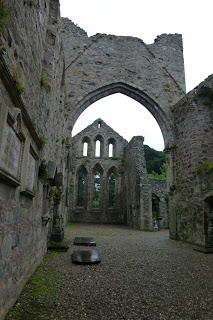
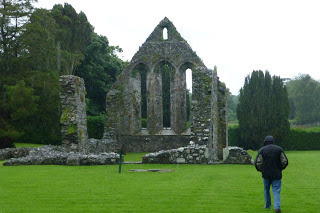 Passing through the dripping garden we entered the ruins. We roamed the grounds, umbrellas firmly grasped, looking at the stones, few in number but resolutely defying time. Interesting architecturally, the abbey was the first gothic-style stone church in Northern Ireland where every window arch and door was pointed rather than round headed. Squishing along we looked at the sodden graveyard wondering how many were there because the potions didn’t work against witches, broken bones or plague. If I was a poet I would have composed an elegy rather like Gray’s Elegy Written in a Country Churchyard in honor of the dismal sight.
Passing through the dripping garden we entered the ruins. We roamed the grounds, umbrellas firmly grasped, looking at the stones, few in number but resolutely defying time. Interesting architecturally, the abbey was the first gothic-style stone church in Northern Ireland where every window arch and door was pointed rather than round headed. Squishing along we looked at the sodden graveyard wondering how many were there because the potions didn’t work against witches, broken bones or plague. If I was a poet I would have composed an elegy rather like Gray’s Elegy Written in a Country Churchyard in honor of the dismal sight.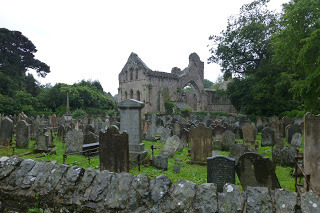
Half-drowned (and seeing no herb that would cast a spell against the rain) we headed for the little town of Donaghadee where Irish Coffee warmed us. The mug of strong coffee, laced with sugar and Irish whiskey and topped with whipped creamed warmed our insides. Our outsides were unexpectedly entertained by some impromptu local color: an elderly man in a black suit hung with medals. He told us that he had just come from a funeral, but more likely it was a long and bibulous wake that prompted his ramblings about the past. Becoming more cheerful he finished up his narrative with a joke: Aer Lingus was over the ocean when one by one the four engines quit. Desperate, the pilot radioed for help. The controller asked for his height and position whereupon the pilot responded that he was 5 foot 7 and sitting in the front of the plane.
We laughed and went on our way. The sun came out.
Published on July 08, 2012 13:28
June 13, 2012
VOODOO FOR BEGINNERS
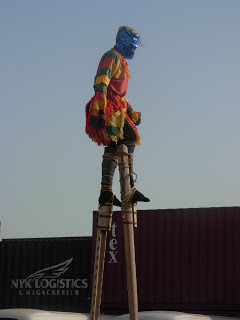 When we docked in Lomé, Togo at seven in the morning it was already burning hot. The stilt dancers and drummers on the dock were dripping with sweat.
When we docked in Lomé, Togo at seven in the morning it was already burning hot. The stilt dancers and drummers on the dock were dripping with sweat. Looking past the exuberant welcome I could see the hospital ship Africa Mercymoored nearby. Lines of sick and injured waited patiently to receive its mercies. The reality of West Africa with its scenes of deprivation mixed with smiles and music were before me.
Our guide and the driver pulled up in an air conditioned van and my husband, Glenn, and I gratefully slid into the delicious coolness. We set off for a day in the countryside with our hospitable twosome who talked about their tiny country and its 40 different ethnic groups. The two men wore the colorful wax printed cotton shirts that make Africans look so elegant. Similar designs were pictured on billboards along the roads near the city advertising a Dutch brand of the patterned wax prints that appear to be almost in motion with their swirling motifs. Outnumbering the attractive signs, dozens of other billboards entreated the populace to be tested for AIDS, to refrain from multiple partners and to be faithful. Some portrayed school-age children as their target audience in an effort to stem the ravages of the disease still scourging Africa.
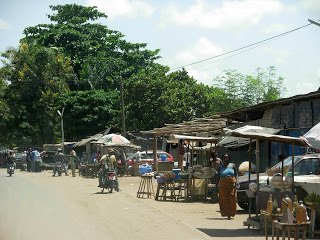 After we left the city behind the road was lined with rickety stands selling food and pop bottles filled with fuel for motorbikes, the only form of public transport. Children were everywhere. Their mothers and older sisters had the smallest tied to their backs, tiny feet sticking out the sides of cloth bindings. The women and girls carried food or laundry in basins on their heads. We passed a small fish market, really just a roadside table. A vulture sat on an overhanging limb eyeing the scene. Towering palms and enormous mango trees laden with ripening fruit shaded grass shacks. Farmers were bent double as they used short hoes to cultivate cassava, yams, sorghum and corn on plots too small for mechanized agriculture. Life looked hard, but even so adults and children smiled and waved as we passed.
After we left the city behind the road was lined with rickety stands selling food and pop bottles filled with fuel for motorbikes, the only form of public transport. Children were everywhere. Their mothers and older sisters had the smallest tied to their backs, tiny feet sticking out the sides of cloth bindings. The women and girls carried food or laundry in basins on their heads. We passed a small fish market, really just a roadside table. A vulture sat on an overhanging limb eyeing the scene. Towering palms and enormous mango trees laden with ripening fruit shaded grass shacks. Farmers were bent double as they used short hoes to cultivate cassava, yams, sorghum and corn on plots too small for mechanized agriculture. Life looked hard, but even so adults and children smiled and waved as we passed. 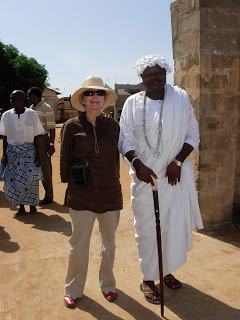
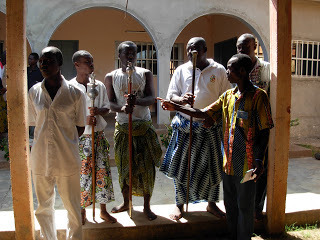 Our first stop was the town of Agbodrafo where the local chief came out to greet us. He was wearing what looked like a woman’s 1950s frilly bathing cap, a long white robe and a heavy chain of office with a pendant representing a traditional chief’s stool. Looking at the photo later it was clear that I was the one in a ridiculous hat. He handed his staff, a relic of Portuguese domination, to a helper before he poured a libation on the ground to welcome us to the dirt-poor collection of hovels built around the ruins of a Portuguese slave trader’s home. The chief’s compound had small cannons and rusted chains piled up against a wall, no doubt more residue from slaving days. The trader’s home, perilously close to collapse, had a plaque outside announcing that the head of UNESCO had visited once. We left a small donation to help in the repair but it seemed doubtful that it was much of a priority. Children and adults followed us as we walked, each side staring at the other, curiosity unassuaged. I tried to imagine their lives as we climbed back into our van, safely divorced from their poverty.
Our first stop was the town of Agbodrafo where the local chief came out to greet us. He was wearing what looked like a woman’s 1950s frilly bathing cap, a long white robe and a heavy chain of office with a pendant representing a traditional chief’s stool. Looking at the photo later it was clear that I was the one in a ridiculous hat. He handed his staff, a relic of Portuguese domination, to a helper before he poured a libation on the ground to welcome us to the dirt-poor collection of hovels built around the ruins of a Portuguese slave trader’s home. The chief’s compound had small cannons and rusted chains piled up against a wall, no doubt more residue from slaving days. The trader’s home, perilously close to collapse, had a plaque outside announcing that the head of UNESCO had visited once. We left a small donation to help in the repair but it seemed doubtful that it was much of a priority. Children and adults followed us as we walked, each side staring at the other, curiosity unassuaged. I tried to imagine their lives as we climbed back into our van, safely divorced from their poverty.
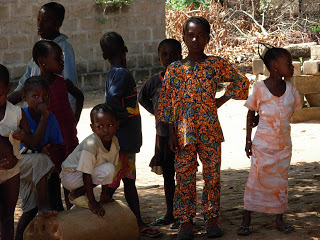
The next stop was to be our introduction to voodoo: a sacred forest near the town of Glidji. Outside the entrance stood a statue stained with some sort of liquids. Some of the drips looked like blood and others looked like – well, I decided I didn’t want to pursue the question.
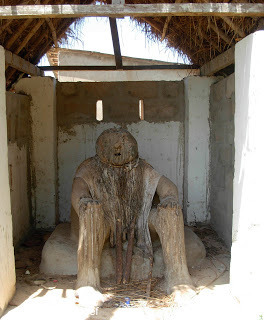 Again we were welcomed with a libation along with a pot of smoking incense. Nearby an enigmatic painted eye and inscriptions painted blue against brilliant white walls overlooked the scene. We were led to a shelter, the entrance to a sacred forest and there we sat with a few priests lounging in the shade. We lounged too until it was time to head for the main event, nothing having transpired in the heat. Not the voodoo we expected – it appeared to be a languid religion.
Again we were welcomed with a libation along with a pot of smoking incense. Nearby an enigmatic painted eye and inscriptions painted blue against brilliant white walls overlooked the scene. We were led to a shelter, the entrance to a sacred forest and there we sat with a few priests lounging in the shade. We lounged too until it was time to head for the main event, nothing having transpired in the heat. Not the voodoo we expected – it appeared to be a languid religion.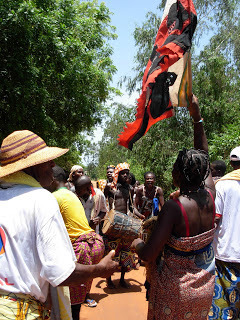 But as our van approached Hlande we could hear drums pounding. Some of the villagers crowded onto the dirt road to welcome us; a single drummer was encouraging them as they waved flags and shouted while we were escorted to the side of a dusty field.
But as our van approached Hlande we could hear drums pounding. Some of the villagers crowded onto the dirt road to welcome us; a single drummer was encouraging them as they waved flags and shouted while we were escorted to the side of a dusty field.
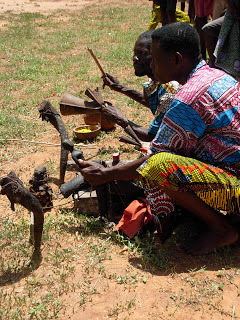
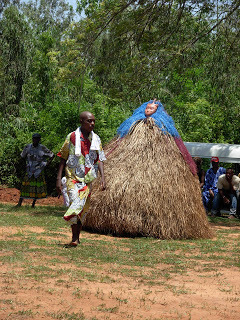 A row of drummers were already pounding, whipping up the crowd in preparation for a Zangbeto dance. Although the sun was high, the ceremony was a ritual celebrating Voodoo night guardians. A priest dressed in red carried a sacred iron bar as he chanted and danced around the field. Several musicians holding fetishes of feathers, bone and hair rang bells and hit other iron bars to encourage the crowd who were already in a state of high excitement.
A row of drummers were already pounding, whipping up the crowd in preparation for a Zangbeto dance. Although the sun was high, the ceremony was a ritual celebrating Voodoo night guardians. A priest dressed in red carried a sacred iron bar as he chanted and danced around the field. Several musicians holding fetishes of feathers, bone and hair rang bells and hit other iron bars to encourage the crowd who were already in a state of high excitement.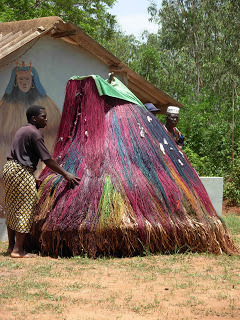
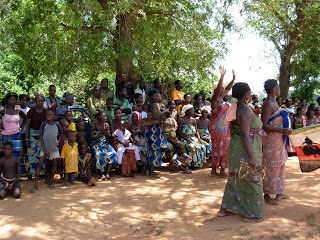 Then what looked like a colored haystack glided into the center of the dusty ground. The villagers in their ever-varied bright prints clapped and sang in encouragement as it began to whirl around and around. Some of the women worked themselves into a trance, writhing and shouting and falling to the ground as the stack spun.
Then what looked like a colored haystack glided into the center of the dusty ground. The villagers in their ever-varied bright prints clapped and sang in encouragement as it began to whirl around and around. Some of the women worked themselves into a trance, writhing and shouting and falling to the ground as the stack spun. 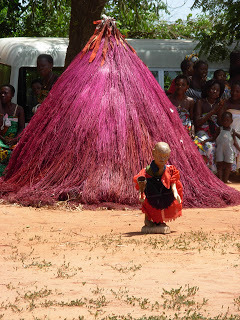 After about ten minutes the music suddenly stopped. In the silence six men rushed to the field to lift up the stack. No one was inside. Instead, as if by black magic, a doll was standing in the red dirt, one arm swinging a bell. Blessing us or invoking a curse? Then the pounding and clanging started again and another raffia covered conical frame spun around and around as if it were a tornado. When the music ceased a different doll waved at us as the haystack was dismantled to show that it had moved without human interference. The procession of haystacks continued and by the time an hour passed I was hypnotized by the boiling head, beating drums, the bells, the iron bars and the ceaseless movement of the women in their dizzying patterned cottons. Disbelief suspended, I could easily believe in Voodoo spells. What happened to the men under the haystacks? No doubt there was a trick but as the sweat poured into my eyes I couldn’t see it.
After about ten minutes the music suddenly stopped. In the silence six men rushed to the field to lift up the stack. No one was inside. Instead, as if by black magic, a doll was standing in the red dirt, one arm swinging a bell. Blessing us or invoking a curse? Then the pounding and clanging started again and another raffia covered conical frame spun around and around as if it were a tornado. When the music ceased a different doll waved at us as the haystack was dismantled to show that it had moved without human interference. The procession of haystacks continued and by the time an hour passed I was hypnotized by the boiling head, beating drums, the bells, the iron bars and the ceaseless movement of the women in their dizzying patterned cottons. Disbelief suspended, I could easily believe in Voodoo spells. What happened to the men under the haystacks? No doubt there was a trick but as the sweat poured into my eyes I couldn’t see it.
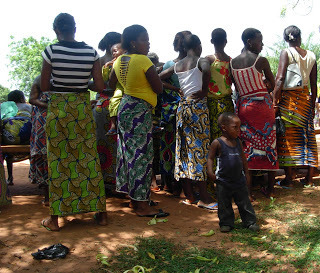
The noise and action continued but being tourists we had a schedule to meet when we wanted to remain. Beautiful children accompanied us back to the van. We were apparently as interesting as the ceremony. As we drove back down the dirt road we could hear the music continuing without us.
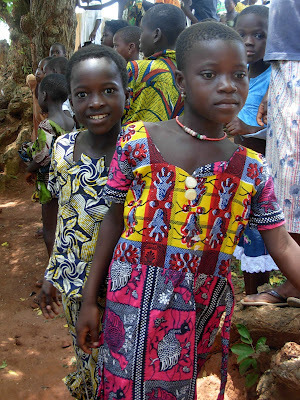
That evening back on the ship gossipers said that we had lost a passenger – he had died in his sleep – and that the widow opted to cremate him while we were in port. A limousine flying American flags pulled up as we were getting ready to cast off. It looked like an urn of ashes was being handed over. Rumor had it that she didn’t want to leave her bridge club to fly home with the remains. This was death number three in only two weeks.
Had a curse been cast on the ship? We wondered if we should have bought potions or talismans in the Fetish Market for protection instead of hand painted greeting cards. We had no one to curse but it would have been interesting to learn if the monkey skull one woman picked up to put a hex on her ex-husband worked as she desired.
Published on June 13, 2012 07:57
June 3, 2012
Girls' Week in Rome
“Should we?” I said to my daughter. And of course she answered, “We should.”
Our husbands rolled their eyes – they’re off again they commiserated.Spring can be pretty dull in Seattle and we needed some sun (and of course good food, wine and shopping). I hadn’t been in Italy since October – too long for me. But I also had a reason to visit Rome other than just enjoying la dolce vita. I’m working on a novel set in Rome and wanted to check out some of the settings to ensure I hadn’t misremembered. (It’s about a couple of expatriates who find that their new life has more complexities than they anticipated.)
Our travel agent soon came up with the arrangement: Seattle – Amsterdam – Rome on Delta for a good price. The flight was uneventful except for breakfast. Being in the back of the bus we didn’t have to worry about gourmet food. Instead we were served a long fat piece of dough filled with an unidentifiable substance. When I asked the cabin attendant what it was she said, “I don’t know – we all have been asking headquarters but they won’t tell us.” I decided not to finish it.
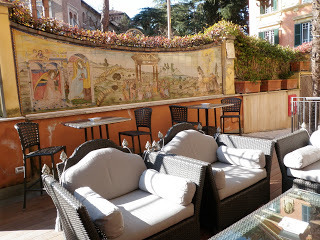
It was hot and sunny when we landed, a perfect beginning. I had booked my favorite hotel, The San Anselmo on the Aventine Hill. The hotel was peaceful and relaxing as usual with outdoor spots to while away the time in the day and a cozy bar for after dinner in the evenings. But we were on the march. The first stop was the Testaccio Market nearby to buy some fruit to snack on and of course to look around – we headed for the shoes and handbags first. It always intrigues me that shoes take up a good part of the market. What are they doing next to the artichokes? The answer: they’re both equally important. Just look at the styles of sandals on all the ancient statues – style goes along with food in Italy and always has.
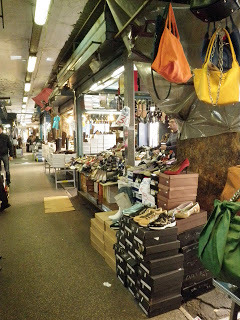 After we finished with the important part of the market we browsed the food. One intriguing stall had a large picture of Padre Pio watching over the tempting treats from the south. We bought packages of pasta made with funghi porcini to take home.
After we finished with the important part of the market we browsed the food. One intriguing stall had a large picture of Padre Pio watching over the tempting treats from the south. We bought packages of pasta made with funghi porcini to take home.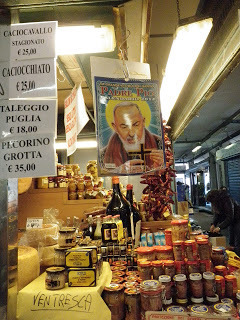
Next stop: Volpetti for some bread, cheese and a few slices of salami. We didn't want to starve between meals and, even if we weren’t hungry, it was an obligatory visit to gaze as the delights of the wonderful deli – the best in Rome.
I had prepared a list of places to see – needed to experience the ambience again and take photos to get the descriptions right for the book’s scenes. The first stop was the Basilica of San Giovanni (the Lateran) to be followed by its more down-to-earth neighbor, the market in Via Sannio. The church was empty at the early hour, long before the tour guides would bring their flocks to see its artistic wonders or to participate in a service. With the absence of crowds it was a special pleasure to linger in the cloister with its lapidary: sarcophagi, reliefs and inscriptions from ancient and medieval times lining the interior walls, and the twisting double pillars encrusted with tiny glass squares framing the garden.
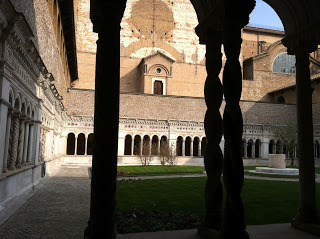
But the Via Sannio market, only a block away through the ancient Aurelian walls, was in full roar, no time for peaceful contemplation, no time for the past. We plunged in to finger the cashmere sweaters, try on the shoes and take photos. Then it was time for late lunch: fabulous Cacio e Pepe at Taverna Cestia with a friend who was on her way to the airport for a visit in Australia.
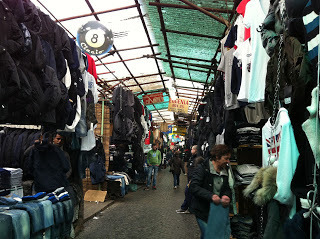
Another day was spent at the Villa Borghese with its sculptures and paintings. I took the time to look closely at the interior decoration, especially the beautiful ceiling frescoes with their birds, foliage, and gods and goddesses. The paintings and sculptures were as marvelous as ever but this visit was especially interesting because interspersed with the regular wonders were some of the sculptures that had been “sold” to Napoleone in 1808. The pieces were on loan from the Louvre whose management apparently didn’t offer to return their spoils of war to their rightful place on a permanent basis.
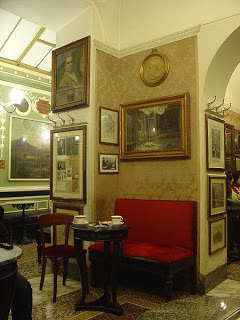
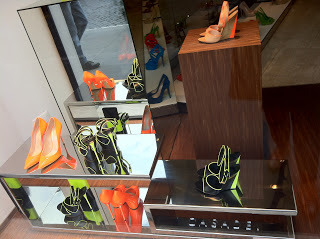 Shopping? Of course there was shopping. Besides the cheap kind in Via Sannio there was the window gazing type on the Via Condotti and the pleasant variety on Viale Europa in EUR, my old stamping grounds. Before leaving the Condotti it was time for a pick-me-up: Oh well, what’s $45 for two glasses of prosecco and a shared cake at Café Greco? The atmosphere at the coffee house, founded in 1760, is worth it once in a while.
Shopping? Of course there was shopping. Besides the cheap kind in Via Sannio there was the window gazing type on the Via Condotti and the pleasant variety on Viale Europa in EUR, my old stamping grounds. Before leaving the Condotti it was time for a pick-me-up: Oh well, what’s $45 for two glasses of prosecco and a shared cake at Café Greco? The atmosphere at the coffee house, founded in 1760, is worth it once in a while.And on we went, only taking one day off to visit the Renaissance Villa Farnese in Caprarola. The enormous Villa is filled with frescos exalting the family and the gardens are a delight filled with statuary and ancient cypresses. Our driver, whom my husband and I had met the previous October, is from the Seychelles and he brought a friend along, a delightful Japanese woman working for the United Nations. This insured lively conversation, especially during our lunch break at a small trattoria with its homemade pasta and grilled meats.
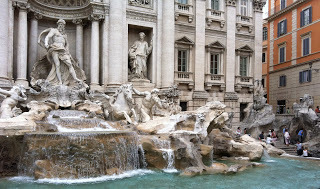 Unfortunately 4:30 AM on the last morning arrived. It was time to leave for the airport. But I wasn’t worried: I had tossed a coin in the Trevi fountain the day before to ensure a return.
Unfortunately 4:30 AM on the last morning arrived. It was time to leave for the airport. But I wasn’t worried: I had tossed a coin in the Trevi fountain the day before to ensure a return.
Published on June 03, 2012 14:14
May 25, 2012
The Scent of Cloves
The rain had stopped. We waited by a five-passenger plane that was to take us to Zanzibar, Tanzania, a 30-minute flight east from Dar es Salaam, the east African country’s largest city. The pilot showed up late, looking distinctly worse for wear with bags under his eyes and a rumpled uniform. His henna-dyed hair showed grey roots.
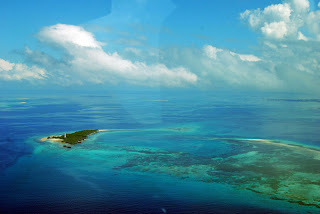 He motioned for us to board, slammed the door shut and fiddled with his instruments. The single engine coughed, then purred and we took off. I looked down at the receding East African city and the clear waters of the Zanzibar Channel and saw the hem of my long silk skirt trailing out alongside the plane. As we stepped onto the tarmac I sighed with relief at being back on terra firma still dressed. Then my husband said, “I hope you didn’t notice the fuel leaking out of the wing.”
He motioned for us to board, slammed the door shut and fiddled with his instruments. The single engine coughed, then purred and we took off. I looked down at the receding East African city and the clear waters of the Zanzibar Channel and saw the hem of my long silk skirt trailing out alongside the plane. As we stepped onto the tarmac I sighed with relief at being back on terra firma still dressed. Then my husband said, “I hope you didn’t notice the fuel leaking out of the wing.”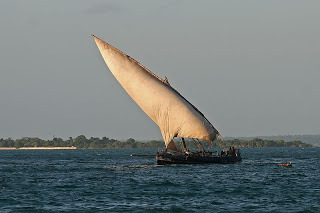 Our hotel, the beautiful Serena, located in historic Stone Town, was a blend of African, Indian and Arab décor in recognition of the ancient trade routes to Oman, Persia and India. Fretwork panels, huge chandeliers, brass studded doors and panels of colored glass graced the lobby and our room. Our balcony overlooked the harbor where dhows with their tattered sails glided by. A vision of the East was before us as we sipped champagne, our welcome drink.
Our hotel, the beautiful Serena, located in historic Stone Town, was a blend of African, Indian and Arab décor in recognition of the ancient trade routes to Oman, Persia and India. Fretwork panels, huge chandeliers, brass studded doors and panels of colored glass graced the lobby and our room. Our balcony overlooked the harbor where dhows with their tattered sails glided by. A vision of the East was before us as we sipped champagne, our welcome drink.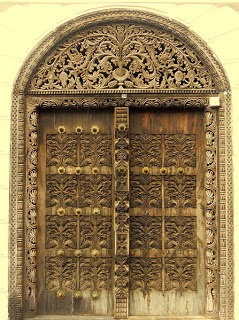 The next day we strolled through the town watching men brewing coffee over tiny charcoal fires, women in their colorful garb and ancient carved doors of Indian design, said to he heavy enough to ward off elephants.
The next day we strolled through the town watching men brewing coffee over tiny charcoal fires, women in their colorful garb and ancient carved doors of Indian design, said to he heavy enough to ward off elephants. We visited the Anglican cathedral with it's cross made of the wood from the tree where the explorer David Livingstone died and the heartbreaking memorial to the nameless slaves who had been sold nearby until the trade was ended in 1883.
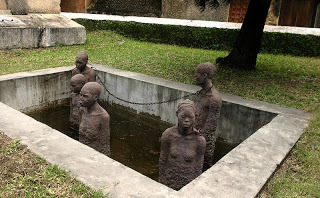
One evening we walked to dinner at Emerson House. The hotel, originally built in the 1820s as an Omani palace, was enlarged 50 years later to add several floors in Anglo-Indian style, complete with Gothic arches and Indian ornamentation. We lounged like sultans on silk cushions under a rooftop awning listening to Mozart on the CD player while savoring our dinner and the pervasive scent of cloves stored for shipment in nearby godowns. The sun declined in the west.
Suddenly, an explosion of sound startled us. First, the Hindu temple directly next door erupted with the sound of bells. When the clanging stopped we heard the sound of more mellow bells announcing evensong for Christians. The sound reverberated through the spice-scented air only to be replaced with a muezzin’s ancient call from the minaret of a nearby mosque.
Night came and the power went out. It was time to leave. We stumbled down steep stairs by candlelight and slowly felt our way down the hill to our hotel, worrying about falling off the foot-high curbs built to keep the walkways above monsoon rains when they pour down the streets in rivers. We came to a mosque and stopped briefly to look in an open barred window. The imam was preaching to the kneeling men by the light of a kerosene lantern. The rapt worshipers looked up, their beards pointed towards him as the age-old words of the Prophet were retold.
Asalaamu alekum. Peace be upon you.
Published on May 25, 2012 12:44
May 9, 2012
A BONE TO PICK - PART III

Before dawn the next morning we drove the short distance to the Egyptian border. Relations were temporarily good so we didn’t expect any problems. We filed off the bus and were inspected, screened, stamped and transferred to an Egyptian bus. Then we sat waiting. Forty-five minutes later the last passenger climbed on. It was our cowboy, who was looking a bit paler than usual. Silently he headed for the back of the bus, his usual position. A guide and another man took the front seats across from the driver. We were finally on our way. Our first stop was the Hilton Hotel at Taba (bombed out a few years’ later with heavy loss of life) for coffee. Off the coast was a tiny island crowned with a 12th castle, marking the most southerly outpost of the short-lived Christian Kingdom of Jerusalem before Salah ad-Din pushed them out. An Israeli guidebook said that it was a Crusader castle; the Egyptians said that it was Moslem. Whoever built it provided a dramatic sight for later arrivals.
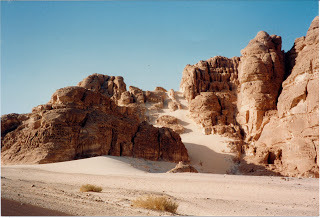
The unidentified man from the front of the bus joined us while we sipped cardamom-flavored coffee. We chatted about our previous trip to Egypt. He allowed that he was our official minder for the day trip, working for the Egyptian security services. Friendly and talkative, he told us about the cowboy. The border guards didn’t like his looks, no surprise, and decided to work him over. Every time he went through the scanner, he set it off. Piece by piece they made him strip until they reluctently relented after recognizing that it was only the steel-shanks in his cowboy boots setting off the alarm.
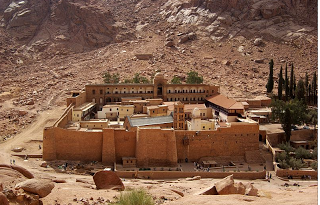
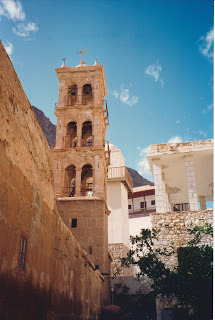 We crossed the barren desert to our goal, the ancient monastery of St. Catherine, founded in 325 by Constantine’s mother, St. Helena (who also found the True Cross in the church of the Holy Sepulcher). It was rebuilt in 548 by Justinian as a fortified monastery. An oasis set in the rocks at the foot of Mount of Moses, Jebel Musa, it was a place of peace, with Muslims and Greek Orthodox co-existing. One writer called the area “God-trodden,” and it seemed an apt description of the isolated area. The carved entrance doors made of Cedar of Lebanon have been used by uncounted pilgrims since the sixth century. Inside the grounds is a mosque for the Bedouins along with the famous flourishing green bush. It is said to be a cutting of the original taken from the site where Moses received the Ten Commandments, now the Chapel of the Burning Bush. It isn't clear what species the Bush is. Some say it is a wild raspberry, others a rose or broom. When there is disagreement about a bush or a castle it is easy to picture all the other intractable disputes over other holy sites.
We crossed the barren desert to our goal, the ancient monastery of St. Catherine, founded in 325 by Constantine’s mother, St. Helena (who also found the True Cross in the church of the Holy Sepulcher). It was rebuilt in 548 by Justinian as a fortified monastery. An oasis set in the rocks at the foot of Mount of Moses, Jebel Musa, it was a place of peace, with Muslims and Greek Orthodox co-existing. One writer called the area “God-trodden,” and it seemed an apt description of the isolated area. The carved entrance doors made of Cedar of Lebanon have been used by uncounted pilgrims since the sixth century. Inside the grounds is a mosque for the Bedouins along with the famous flourishing green bush. It is said to be a cutting of the original taken from the site where Moses received the Ten Commandments, now the Chapel of the Burning Bush. It isn't clear what species the Bush is. Some say it is a wild raspberry, others a rose or broom. When there is disagreement about a bush or a castle it is easy to picture all the other intractable disputes over other holy sites.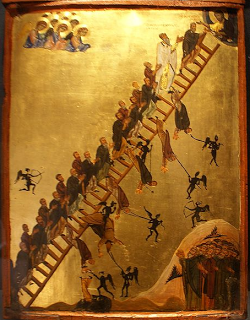 The basilica’s interior is hung with enormous silver chandeliers laden with yellow beeswax candles, votive lamps surmounted with ostrich eggs suspended from the ceiling and ancient icons of incalculable value, some from the time of the monastery’s founding.
The basilica’s interior is hung with enormous silver chandeliers laden with yellow beeswax candles, votive lamps surmounted with ostrich eggs suspended from the ceiling and ancient icons of incalculable value, some from the time of the monastery’s founding.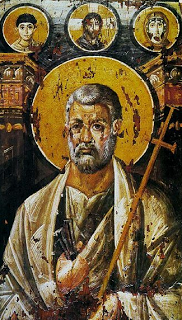
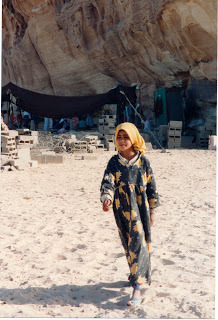 We were sorry to leave and hoped that some day we could return to hike the steep 750 Stairs of Repentance to the top of Jebel Musa to watch a sunrise and repent our sins. But our minder herded us back on the bus for the next big event, “tea with the Bedouins,” a faked tourist attraction but thought-provoking nevertheless with little girls with unkempt hair peeking out from behind rocks to watch us while women stayed out of sight. The girls eventually crept out and joined the boys. After handing out the pens and candies we carried to give to them, we sat in the sand around a small fire, hoping to avoid some disease from dirty water or hands of the men who prepared tea and poured it in smudged glasses while the flat bread baked in the ashes. When their cooking duties were finished, the men lay on the ground propped up on one elbow smoking in front of a cave stocked with provisions including plastic crates for soft drinks, jerry cans and Adidas carry-alls. Rubber sandals were carelessly discarded in the sand. Camels rested some distance away near battered Toyota pickups. A beautiful girl dressed in a blue robe with yellow flowers came out to sell some trinkets. She sat in front of the community grocery store – a little turquoise painted cupboard stocked with a few cans of fish, biscuits and other odds and ends. Camel bags hung on one side of the shop and a dish towel on the other. We wondered what these restless people thought of us staring at them and taking pictures. Outwardly they didn't seem to care, but inwardly?
We were sorry to leave and hoped that some day we could return to hike the steep 750 Stairs of Repentance to the top of Jebel Musa to watch a sunrise and repent our sins. But our minder herded us back on the bus for the next big event, “tea with the Bedouins,” a faked tourist attraction but thought-provoking nevertheless with little girls with unkempt hair peeking out from behind rocks to watch us while women stayed out of sight. The girls eventually crept out and joined the boys. After handing out the pens and candies we carried to give to them, we sat in the sand around a small fire, hoping to avoid some disease from dirty water or hands of the men who prepared tea and poured it in smudged glasses while the flat bread baked in the ashes. When their cooking duties were finished, the men lay on the ground propped up on one elbow smoking in front of a cave stocked with provisions including plastic crates for soft drinks, jerry cans and Adidas carry-alls. Rubber sandals were carelessly discarded in the sand. Camels rested some distance away near battered Toyota pickups. A beautiful girl dressed in a blue robe with yellow flowers came out to sell some trinkets. She sat in front of the community grocery store – a little turquoise painted cupboard stocked with a few cans of fish, biscuits and other odds and ends. Camel bags hung on one side of the shop and a dish towel on the other. We wondered what these restless people thought of us staring at them and taking pictures. Outwardly they didn't seem to care, but inwardly?
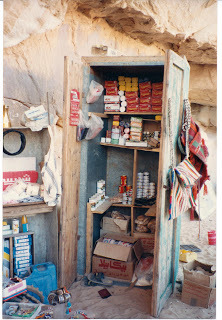
As we left the bus at the border, our minder kindly gave Glenn a paper cornucopia of cardamom flavored coffee as a memento. “Shokran,” I said, using my small store of Arabic words. Cardamom: always to be used in small amounts, always reminding me of this trip, where if the dose is too large the taste is bitter.
The security check leaving Israel was complete with extensive questioning and pat-downs, equally as vigorous as that in London when we had boarded the flight to Tel Aviv. It was six in the morning when we took off on the long trip home. My seatmate on the window side was an elderly bewigged woman loaded with shopping bags. She kept asking in a heavy accent if I knew where Golders Green in London was. I didn't. The rows across, in front and in back of us were filled with soldiers on leave from their UN peacekeeping duties in the Sinai set up as part of the Camp David Accords. They were determined to enjoy their leave and by 7 a.m. they were drunk and disorderly with joy and gin. It was a long flight from a land of milk and honey where the thought of a peace somehow actually arriving was too remote even to contemplate.
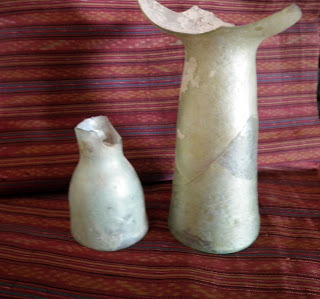 At home, we looked at the larger of the old glass bottle tops. As we turned it over, the ash fell out revealing a small bone – a finger or a toe, or only a bird bone buried for millennia. How could it have ended up in a Roman glass bottle fragment? We never tried to find out, preferring to leave the mystery unsolved.
At home, we looked at the larger of the old glass bottle tops. As we turned it over, the ash fell out revealing a small bone – a finger or a toe, or only a bird bone buried for millennia. How could it have ended up in a Roman glass bottle fragment? We never tried to find out, preferring to leave the mystery unsolved.
Published on May 09, 2012 15:22
April 28, 2012
A BONE TO PICK PART II
We had been surprised when our guide, Rivka, launched into a vigorous tirade about the ultra Orthodox as soon as the tour started. She claimed their women did nothing but have babies while the men lived on State handouts while they studied the Talmud in a yeshiva. The most radical denied the existence of the State and were exempt from serving in the army she told us with disgust. It was apparent that even among those of her religion there was plenty of tension. We let her comments pass unquestioned but when we arrived at our Jerusalem hotel on a Friday afternoon we hurried to the ultra-Orthodox district, Mea Shearim, to see who she was talking about. Near the entrance to the quarter signs advised women to cover up for modesty. I complied.
It wasn't long before the Sabbath warning horn sounded. Men, wearing high boots and and caftans, held on to their fur hats as they hurried home. The large hats were brimmed with luxurious sable or martin. Even in a city of religious garb, cassocks, birettas and cowls, head scarves, crocheted caps, yarmulkes, turbans and prayer shawls, their appearance was otherworldly, as if people from16th century shtetls in dank Poland had suddenly been transported to the sun and heat of a land of olive trees and cypresses. A little boy, one hand holding his father’s and sucking his other thumb as they headed for home, looked serious and pale with his red hair dropping in a shoulder length curl on each side of his ears. He frowned at us, nosy interlopers that we were.
The next day we rambled through crowded streets of the Old City absorbing the atmosphere within the ancient walls. Beautiful domes and spires reaching into the blue sky belied the fight for religious or temporal power going on at ground level. Christians dragged or carried large wooden crosses down the narrow Via Dolorosa. It was packed with other less overt pilgrims with Bibles in hand; tourists in brief tee-shirts, shorts and baseball caps; merchants screaming our their wares; and the Orthodox, heads down and hiding under their prayer shawls, trying to make their way to the Wailing Wall. If someone had shouted “fire,” or more likely, used a slingshot to cast a stone like David against Goliath, we would have been trampled to death in a stampede. In a small plaza, we came across a car with the windows covered with paper. The police were standing around looking at it. A bomb, a body? Just another day in Israel.
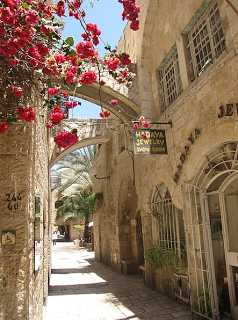
The Arab quarter had stalls selling clothing, dried beans and fruit, sandals, and cheap videos. Idle youths propped up the walls. Elderly men with old suit jackets over their white robes, checked headdresses held in place with a cord, worry beads and canes led loaded donkeys. Women, in their long gowns and headscarves, hurried along as they did their shopping, children in tow.
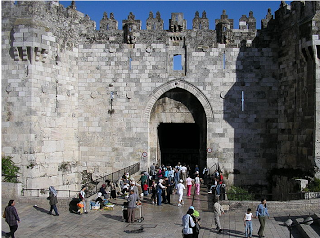 We left the Old City by the Damascus Gate. An Israeli soldier with an Uzi sat in the small window overlooking the square. Other soldiers screamed at the Palestinians or drove through the thick crowds in their military vehicles with little care for anyone’s safety, blowing their horns and waving guns. Our goal was the Rockefeller Museum, located on the site where Crusaders stormed the city in 1099. No one wanted to let us in until our motives were ascertained. We looked innocent although a guard shadowed us as we wandered the rooms empty of visitors but filled with artifacts from every period of history. On the way out we noticed that the roof was crammed with antennae of every sort, no doubt having nothing to do with artifacts from the prehistoric era.
We left the Old City by the Damascus Gate. An Israeli soldier with an Uzi sat in the small window overlooking the square. Other soldiers screamed at the Palestinians or drove through the thick crowds in their military vehicles with little care for anyone’s safety, blowing their horns and waving guns. Our goal was the Rockefeller Museum, located on the site where Crusaders stormed the city in 1099. No one wanted to let us in until our motives were ascertained. We looked innocent although a guard shadowed us as we wandered the rooms empty of visitors but filled with artifacts from every period of history. On the way out we noticed that the roof was crammed with antennae of every sort, no doubt having nothing to do with artifacts from the prehistoric era.
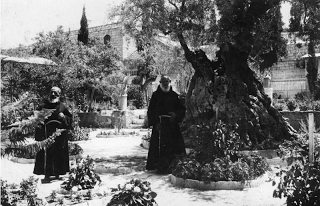 We walked to the Garden of Gethsemane. It was the only peaceful site we found even though sirens sounded in the distance and a slight smell of tear gas wafted near the giant olive trees in the beautiful garden, the setting for betrayal.
We walked to the Garden of Gethsemane. It was the only peaceful site we found even though sirens sounded in the distance and a slight smell of tear gas wafted near the giant olive trees in the beautiful garden, the setting for betrayal. 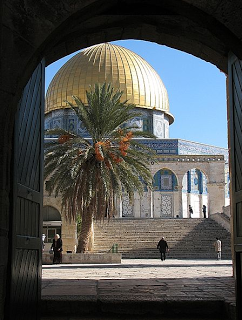 A temporary lull in the perpetual contest for power allowed a visit to the Temple Mount where Solomon’s Temple housed the Ark of the Covenant until it was destroyed in 587 BC by Nebuchadnezzar. Nothing is left of that temple although there are a few remains of the Second Temple built by Herod. The area fell into ruin until the arrival of the Moslems in AD 638. They cleaned it up and built two famous mosques. The mosaic-encrusted Dome of the Rock, was designed by Christian architects – a rare example of ecumenism. The golden-domed octagonal building surrounds a rock where Abraham prepared to sacrifice his son Isaac and Mohammed temporarily ascended into heaven astride his horse. The King of Jordan was assassinated there by fanatics in 1951. The silver-domed Al-Aqsa Mosque nearby was built on the ruins of a Byzantine basilica. Some years later it was damaged by gunfire and then a crazed Australian tried to burn it down.
A temporary lull in the perpetual contest for power allowed a visit to the Temple Mount where Solomon’s Temple housed the Ark of the Covenant until it was destroyed in 587 BC by Nebuchadnezzar. Nothing is left of that temple although there are a few remains of the Second Temple built by Herod. The area fell into ruin until the arrival of the Moslems in AD 638. They cleaned it up and built two famous mosques. The mosaic-encrusted Dome of the Rock, was designed by Christian architects – a rare example of ecumenism. The golden-domed octagonal building surrounds a rock where Abraham prepared to sacrifice his son Isaac and Mohammed temporarily ascended into heaven astride his horse. The King of Jordan was assassinated there by fanatics in 1951. The silver-domed Al-Aqsa Mosque nearby was built on the ruins of a Byzantine basilica. Some years later it was damaged by gunfire and then a crazed Australian tried to burn it down.But the only violence that we wanted to see was not in evidence: the dark and dreary Church of the Holy Sepulcher where priests and monks from six Christian communities regularly battle it out with brooms over who controls what piece of the building. The Franciscans, Greek Orthodox, Ethiopians, Copts, Armenians and Syrians were otherwise occupied that day as we tried to think holy thoughts in a circus atmosphere with dozens of guides herding their noisy charges around the sacred monument. Jesus would have turned over in his grave, if He had one.Near the King David Hotel, where Jewish terrorists blew up one wing in 1946 killing many British soldiers, shop windows were loaded with silver menorahs and other Jewish ritual objects. Next to the Dallas Kosher Oriental “Restaurent” with a cowboy on a horse painted on their window, we found a small shop with old coins, Roman glass and other antiquities. Resting by the door was a basket containing partial pieces of opalescent glass. Lured by blue green patina, we picked up a piece and bought it for a small sum. It was the top half of a bottle or a jar. When we looked at it more closely we could see that it was packed with ash from some ancient disaster.
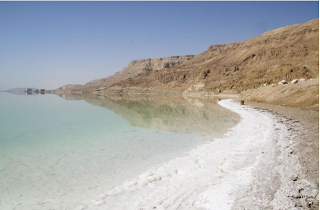 Down, down to the Dead Sea, the lowest place on earth. We shared the ever-shrinking Sea with war veterans covered with scars trying to ease their aches in the greasy-feeling mineral warmth of the buoyant water. Masada’s rocky outcrop, where Herod’s fortress once stood and the Zealots held out against the Romans, loomed over the Sea. As we rode to the top in a cable car, soldiers in training were running up the steep path. Pieces of Roman columns lay on the ground. Roman numerals, still clear, showed which piece should be connected to its mate. When we looked over the sides of the fortress, the desert soil revealed the outline of Roman encampments and the ramp used by their army in AD 73 to end the three-year siege. When they entered the ruins, the Romans found 960 bodies of the Jewish Zealots who died rather than submit to Rome.
Down, down to the Dead Sea, the lowest place on earth. We shared the ever-shrinking Sea with war veterans covered with scars trying to ease their aches in the greasy-feeling mineral warmth of the buoyant water. Masada’s rocky outcrop, where Herod’s fortress once stood and the Zealots held out against the Romans, loomed over the Sea. As we rode to the top in a cable car, soldiers in training were running up the steep path. Pieces of Roman columns lay on the ground. Roman numerals, still clear, showed which piece should be connected to its mate. When we looked over the sides of the fortress, the desert soil revealed the outline of Roman encampments and the ramp used by their army in AD 73 to end the three-year siege. When they entered the ruins, the Romans found 960 bodies of the Jewish Zealots who died rather than submit to Rome. Worn out with an overdose of violent history, we were happy to head to Eliat, Israel’s Red Sea port and playground, stopping at the purported site of King Solomon’s mines where Egyptians mined copper as early as 3000 BC, long before Solomon existed. We climbed the high rocks and then, back at the bus, watched as several of our tour group overestimated their climbing abilities, unable to find their way down. Time was passing and the sun was setting. Glenn climbed up to lead them back from their mini adventure.
Published on April 28, 2012 07:03
April 18, 2012
A Bone to Pick - Part I
The weather at home was cold and damp. We wanted to go someplace warm and dry. On my lunch hour I contemplated the travel brochures displayed in the window of a travel agency next door to my office. Mexico, the Caribbean…or where? Lured inside by the thought of sunshine, I spotted the agent who looked like a pixie with her gamin haircut. She wore a tunic and brown hose with little green suede shoes that curled up at the toes. I asked her for some ideas, expecting from her appearance to be sent to rainy Ireland. Instead, she said a stack of flyers for a tour of Israel had recently arrived. “Would you like one?” “Why not?”
The itinerary of the two week tour covered all the tiny country from the Lebanese border and Golan Heights to the Red Sea. Tipping the scales in favor was the opportunity to see the cradle of Christianity and a day trip to ancient St. Catherine’s Monastery, home of the Burning Bush, located near the tip of the Egyptian Sinai Peninsula. We had been in Egypt several years before to see the standard sights but hadn’t had the time to leave the Nile Valley. The next lunch break I handed over my credit card.
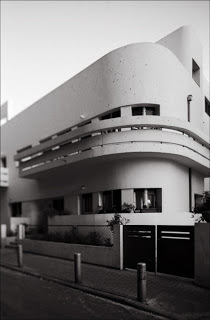 We landed in Tel Aviv at dawn. We had hours to start looking around before meeting the tour group; not a minute to waste. Buildings from the 1930s designed in the Bauhaus International style were glowing white in the morning sun. Awnings over the stalls in the Carmel Market sheltered piles of fresh fruit and vegetables and other odds and ends typical of the Levant – spices, nuts, dried fruit and olives in burlap sacks. We wandered to the ancient town of Jaffa. The Greeks believed that Perseus on his winged horse rescued Andromeda from a rock in the harbor. In Biblical tradition, it was founded by Noah’s son Japheth after the Flood and was where Jonah was cast ashore after his adventure with the whale. As part of its great trading history, it served as the port for the cedars of Lebanon used in the construction of Solomon’s Temple. By the time we arrived it was a picturesque suburb filled with souvenir shops, a flea market and restaurants for tourists.
We landed in Tel Aviv at dawn. We had hours to start looking around before meeting the tour group; not a minute to waste. Buildings from the 1930s designed in the Bauhaus International style were glowing white in the morning sun. Awnings over the stalls in the Carmel Market sheltered piles of fresh fruit and vegetables and other odds and ends typical of the Levant – spices, nuts, dried fruit and olives in burlap sacks. We wandered to the ancient town of Jaffa. The Greeks believed that Perseus on his winged horse rescued Andromeda from a rock in the harbor. In Biblical tradition, it was founded by Noah’s son Japheth after the Flood and was where Jonah was cast ashore after his adventure with the whale. As part of its great trading history, it served as the port for the cedars of Lebanon used in the construction of Solomon’s Temple. By the time we arrived it was a picturesque suburb filled with souvenir shops, a flea market and restaurants for tourists.
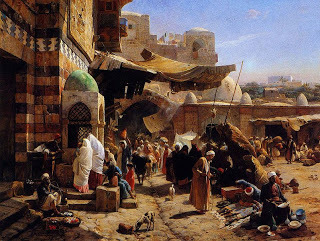
When our group met in the lobby, our guide introduced herself as Rivka. Fluent in Arabic along with Hebrew, Swedish and English, she had served as a translator for prisoner exchanges after wars with Egypt and was an expert in local history. Her flock was an odd assortment of Americans all with different motivations for the trip: elderly Jews who would stay on after the tour to try to find their relatives, young non-observant Jews wanting to see Israel with the ease of a tour, a couple on their honeymoon who dragged their new Burberry coats along in the heat everywhere they went, an elderly Sunday school teacher desperately trying to understand the New Testament about which he seemed to know nothing, the nominally Christian like ourselves, and a youngish man in brown polyester with shifty eyes and cowboy boots who lurked on the fringe and kept to himself. Each of us would incorporate our own backgrounds and motivations to see Israel through different lenses.
The next morning our tour commenced: baggage out by 7 a.m., group on the bus by eight. The complex, entangled layers of history were immediately on display; a palimpsest where one civilization rubbed out another. Hatred and violence were a constant, never-ending theme at every site. We tramped through Iron-age sites like tiny Meggido (Armageddon), Roman ruins, Byzantine churches and their mosaics, Crusader castles, ancient synagogues, mosques and churches and those of more recent times. Our Sunday school teacher entertained us regularly with, “I didn’t know that!!” The man in brown polyester sat in the back of the bus, alone.
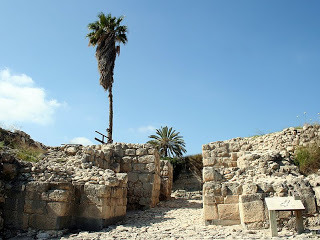
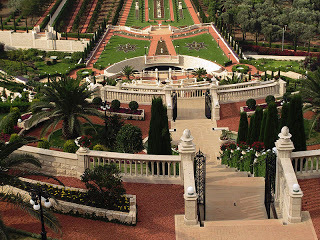 In Haifa, the Persian flower gardens of the oft-persecuted Baha’i sect overlooked the site where a few boats managed to bring Jews to the Promised Land after running the British blockade after World War II. We stopped at the Lebanese border where a sign painted on a rock said Beirut 120 km, Jerusalem 205 km. That was the physical distance, but the mental distance seemed more like from there to the moon. We were near the entrance to a railroad tunnel, part of the tracks built in the Ottoman era. I expected Lawrence of Arabia to ride out leading his Arab insurgents on their stallions. Instead, a wedding was in process. The groom was attended by his fellow soldiers dressed in battle fatigues and carrying Uzis; the bride was in a shiny white gown covered in ruffles and flourishes. We joined in wishing them well while wondering about their future.
In Haifa, the Persian flower gardens of the oft-persecuted Baha’i sect overlooked the site where a few boats managed to bring Jews to the Promised Land after running the British blockade after World War II. We stopped at the Lebanese border where a sign painted on a rock said Beirut 120 km, Jerusalem 205 km. That was the physical distance, but the mental distance seemed more like from there to the moon. We were near the entrance to a railroad tunnel, part of the tracks built in the Ottoman era. I expected Lawrence of Arabia to ride out leading his Arab insurgents on their stallions. Instead, a wedding was in process. The groom was attended by his fellow soldiers dressed in battle fatigues and carrying Uzis; the bride was in a shiny white gown covered in ruffles and flourishes. We joined in wishing them well while wondering about their future. Back in the bus, the TV was turned on. CNN was showing pictures of tanks being hauled on low-boys toward some threatened destination. I looked out the window: there were the very tanks. Rivka assured us there was no problem, but our evening’s destination, a kibbutz, was in the same direction. On arrival we were treated to a view of their bomb shelter and a children’s playground with a half-buried Syrian MIG where it came to rest after being shot down. The current shooting was near the next kibbutz to the north. We were restless thinking about the stress of living in such an unstable environment and worrying that the current fighting might come our way.
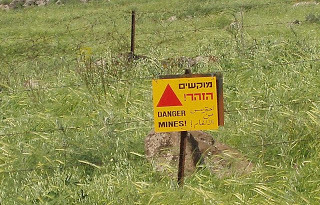 More Middle-East politics confronted us when we viewed Israel from the Golan Heights. We drove half-way up the mountains on a road lined with signs warning of landmines. We stopped at a viewpoint. Above us were communications towers and below us was the country. The Jordan River looked to be a creek. Nearby was an Israeli monument to the fallen, small pebbles of remembrance instead of flowers scattered on the flat surface. Wreaths made of dried grasses and wildflowers hung on black steel anti-tank barricades.
More Middle-East politics confronted us when we viewed Israel from the Golan Heights. We drove half-way up the mountains on a road lined with signs warning of landmines. We stopped at a viewpoint. Above us were communications towers and below us was the country. The Jordan River looked to be a creek. Nearby was an Israeli monument to the fallen, small pebbles of remembrance instead of flowers scattered on the flat surface. Wreaths made of dried grasses and wildflowers hung on black steel anti-tank barricades. 
Safed, the center of Jewish mysticism was next on our itinerary. On the way we passed burned out buses and trucks from the 1947 war when Palestinians were forced out. Our strange cowboy-booted companion bought piles of rams’ horns and, in an uncharacteristic burst of volubility, told us that they were for a new sect he had founded in prison. No one could think of anything to say other than, “that’s interesting,” while picturing men in black and white stripes blowing on the horns in an exercise yard. Not wanting rams’ horns, I spotted a copper coffee pot that I thought had Arabic calligraphy as a decoration. After hearing the price, I countered with a slightly lower offer. The vendor looked at me and said, “If you want it, lady, pay the price.” I meekly paid. Later I looked more closely at my purchase - it wasn't calligraphy, it was a dragon and the spout when turned upside down was an elephant's head. Where did this object come from? Was it fake, was it real from some exotic place. Who knows?
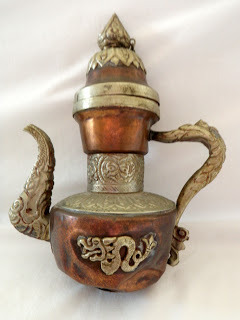
Nazareth has an enormous Franciscan church honoring the Virgin Mary with the nave lined with gigantic mosaics picturing her in the costume of the country that donated the panel. The Japanese donation was eye-catching with Mary in a kimono. Rather than view the church, two elderly Jews wandered off. We waited on the bus while Rivka searched the narrow streets and passages. By the time she found them they were hysterical with fear at being lost among local Palestinians. She led them back to the bus where they sobbed and comforted each other on the way to our next stop.
We arrived in golden-hued Jerusalem, the medieval center of the world and the holy city of various aspects of God. It was a Friday; the Jewish Sabbath started at sundown.
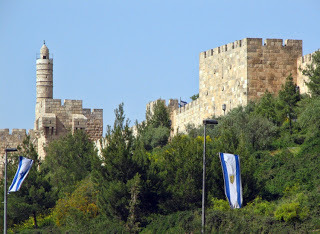
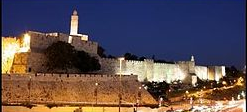
Published on April 18, 2012 08:31
April 7, 2012
Stomach Troubles
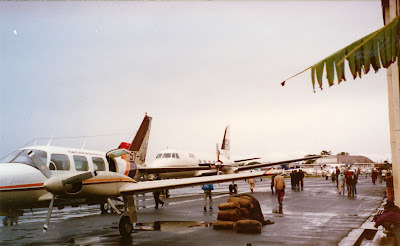
Wilson Airport in Nairobi was busy though it was barely dawn. Single-engine planes lined up for takeoff, one after the other. "Where are they going?" I asked. The answer: "To Somalia, to deliver khat." Bags and bundles of the narcotic herb were being loaded into other small planes while I waited along with several United Nations staff to fly to Lokichokio.
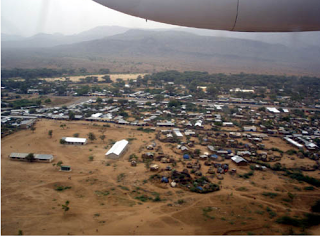
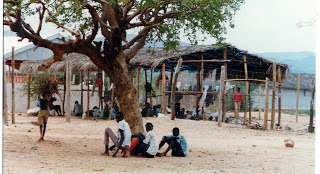 After an hour's flight near the Rift Valley, we landed on a runway where some of the parked planes had bullet holes to show for their efforts to provide aid in the protracted conflict in southern Sudan. The settlement, no more than 20 miles from the Sudanese border, was populated by the native Turkana tribe, Sudanese refugees, termite mounds, herds of donkeys and goats, and aid organization offices. Turkana people wearing only a few beads sat in front of their grass covered huts, without interest in us. Dispirited refugees squatted in insufficient shade provided by stick-roofed shelters.
After an hour's flight near the Rift Valley, we landed on a runway where some of the parked planes had bullet holes to show for their efforts to provide aid in the protracted conflict in southern Sudan. The settlement, no more than 20 miles from the Sudanese border, was populated by the native Turkana tribe, Sudanese refugees, termite mounds, herds of donkeys and goats, and aid organization offices. Turkana people wearing only a few beads sat in front of their grass covered huts, without interest in us. Dispirited refugees squatted in insufficient shade provided by stick-roofed shelters. The isolated airstrip was used to air drop food to desperate Christian and animist Sudanese under attack from the Moslem Janjaweed militia. This militia, made up of nomadic tribesmen, was supported by the Sudanese government who used them as a proxy to drive out the sedentary farming population and force them to surrender the land rich in resources. Janjaweed means "devils on horseback," an apt name for the massacres and rapes they perpetrated. The militia sometimes pursued aid workers along with the rebels. Another bloody game in which the innocent starved.
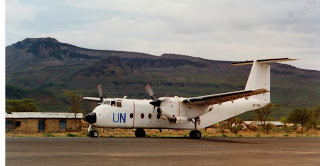 The airport consisted of a fuel dump, small control tower and several rub halls, huge tents that aid agencies use to store emergency supplies. The tents held tins of cooking oil and grain and legumes ready to be triple bagged and loaded on an old twin engine Canadian Buffalo airplane, a design known for its ability to take off and land on short airstrips. Sweating workers were slinging 120 pound sacks of food into the plane's cargo area. The sacks were to be air-dropped as the plane flew at an altitude of only 1600 feet to help ensure the bags didn't break on landing. Food aid monitors had already marked drop points on the other side of the border awaiting the delivery. Village headmen were ready to gather the bags and oversee distribution to women who had registered their families, the amount doled out depending on the family size and ages. Did I want to go on a flight? Yes I did, but with no authorization from the Sudanese authorities, it was too much of a chance. Instead, I watched the plane lumber down the airstrip and take off over the brush covered hills to return empty an hour or so later.
The airport consisted of a fuel dump, small control tower and several rub halls, huge tents that aid agencies use to store emergency supplies. The tents held tins of cooking oil and grain and legumes ready to be triple bagged and loaded on an old twin engine Canadian Buffalo airplane, a design known for its ability to take off and land on short airstrips. Sweating workers were slinging 120 pound sacks of food into the plane's cargo area. The sacks were to be air-dropped as the plane flew at an altitude of only 1600 feet to help ensure the bags didn't break on landing. Food aid monitors had already marked drop points on the other side of the border awaiting the delivery. Village headmen were ready to gather the bags and oversee distribution to women who had registered their families, the amount doled out depending on the family size and ages. Did I want to go on a flight? Yes I did, but with no authorization from the Sudanese authorities, it was too much of a chance. Instead, I watched the plane lumber down the airstrip and take off over the brush covered hills to return empty an hour or so later.
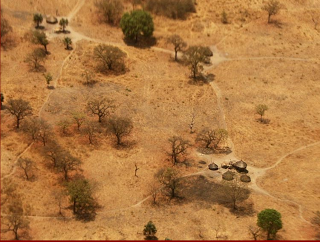
Lunch was served in a cafeteria used by the aid workers where Western food was supplemented by local food for the Kenyans. I was hungry after the early start and scooped up spicy goat stew, tough but tasty. The aid workers' simple accommodations had insect ridden thatch-roof huts and communal showers. No TV. Only the most adventurous and self-sufficient took these jobs and even they didn't stay more than a year or two. Part of the reason for my trip was to talk to these workers to assess the need for expanding our counseling service which attempted to assist them in coping with the rigorous and dangerous conditions. A need for the program was obvious when women food aid monitors told me about running for their lives and hiding in the scrub for days to escape the Janjaweed marauders before being rescued.
Mission accomplished and dusk falling, I was glad to get on the 20-passenger plane for the flight back to Nairobi. Fellow passengers on the homebound leg were a few UN workers and several extremely tall, thin and blue-black Sudanese, silent and dignified in their white robes and turbans.
My hotel was the Norfolk, with little plaques on some room doors where Teddy Roosevelt and Ernest Hemmingway had slept, although Ernest was said to have spent most of his time in the bar. I sat on the veranda in the early evening watching business people relaxing over bottles of Tusker beer and vans rolling up, sliding open their doors and gathering up Americans wearing their brand-new safari outfits. They were all trying to look like Robert Redford in Out of Africa as they ventured out to the bush for a few days' sightseeing in the game parks. Across the street, students were loudly protesting some issues at the nearby university. The power went out.
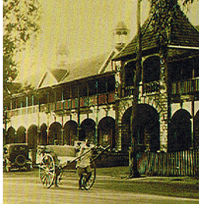
The breakfast buffet the next morning was extravagant in its variety and I assumed the fruit had all been carefully washed. Within two hours I was vomiting uncontrollably and having the DTs while lying in the UN infirmary. Although the doctor wasn't much impressed I had visions of a lonely death while being besieged by imaginary wild animals and ghosts. So much for my brave African adventure. After the more unpleasant symptoms abated, the office director's wife hauled me off to their home where I slept off the remainder of the problem, dozing with the faint smoke of the mosquito coil keeping me company.
My rescuers were hosting a party that evening. I managed to pull myself together and lurch out into the garden to make a late appearance. The house was a fortress: guards with their leashed German shepherds, broken glass topping the garden walls and bars on the windows. Talk at the party turned to the dangers in Nairobi where the chief of security for the UN had been murdered in a carjacking. Out of the corner of my eye I could see two men leaping over a hedge. Good God, were we going to be attacked? No, it was the guards on patrol.
The next evening, I waited for an old unmarked taxi to take me to the airport. It was too dangerous for a UN vehicle to drive the route after dark due to the many carjackings of their desirable nearly new SUVs. The airport was in disrepair. Empty sockets stared at me in place of ripped out video monitors. The flight back to the bounty and peace of Rome gave me time to think about the unhappy lives of those caught in the middle of never-ending violence. Excerpt from Coins in the Fountain
Photo of Sudan courtesy BBC
Published on April 07, 2012 08:18
March 30, 2012
An Easter Holiday
One Easter I went on a voyage to bring a friend's boat, the Virginia, to Corfu, Greece from Bodrum, Turkey where she had been resting in dry storage for the winter. Not being much of a sailor, I needed encouragement before agreeing to serve as third mate. A tour of Cappadocia and the chance to check out carpets were the enticements. I helped pack up food stores and a new rubber life raft. My husband and I flew with the owners to Athens and on to the island of Kos where we had booked a hotel unfortunately populated with drunken and naked Finns desperate for sun. Alongside their more shapely grandchildren, aged and fat grandmothers lay by the pool without clothes or concern, looking like basking sea lions. We tried hard to look the other way but we couldn't resist surreptitiously staring as each movement redistributed their jiggling flesh.
It was Orthodox Easter. We attended a midnight service and afterward watched as the populace took their beeswax candles home where the smoke from the burning wick was used to make the sign of the cross on door lintels. The following day we enjoyed a lamb barbecue at the port before we took the ferry to Bodrum, leaving the Christian world for that of the Moslem. The departure timing was fortuitous because the next day the ferry caught fire coming into port. No one was injured but the thought of a choice between roasting and drowning wasn't one I wanted to contemplate.
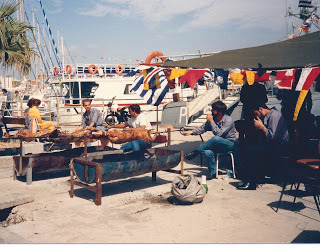
Before the Virginia was returned to her natural element we rented a car to tour Cappadocia in central Turkey. Our route led us past gas stations with a small mosques attached and towns with groves of poplar trees shooting their fresh green leaves high in the sky. Crumbling caravansaries served as picnic sites where children begged for money calling out, "pourboire," French for a tip. Heavily guarded opium poppy fields, grown for pharmaceutical purposes we assumed, colored the landscape with their purple flowers. At one stop when Glenn gave a candy to a little girl her friend came rushing up to remind her that it was Ramadan. She quickly spit it out and put it in her pocket to savor after sundown.
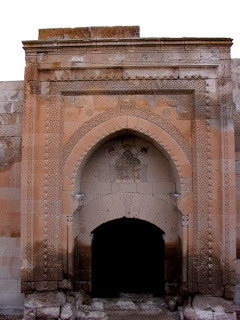
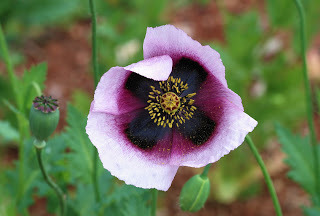
We arrived in Isparta seeking shelter for the night. Looking as confused as only tourists can we were rescued by two men in a car who pulled up beside us to say hello. We said, "want hotel" while I held up my four fingers to illustrate that we wanted something nice. The driver smiled and waved us to follow him. He drove up to a brand new otel and pointed before he drove off with a wave.
It was luxurious. As we checked in local army officers arrived in their staff cars with flags flying from front fenders. They were gathering for a Rotary Club meeting, Americana in an unlikely location. The hotel restaurant was taken over by the Rotary. The hotel staff pointed us to a restaurant several blocks away. All eyes turned in our direction when we entered. Smiles followed and the cook invited us into his kitchen where we pointed at what looked good. Various tasty combinations made with tomatoes, eggplant and lamb soon filled our plates. The restaurant was crowded with the local soccer team. A man motioned to us to sit with him at the only table with space. He was an engineering professor with good English and was happy to talk about his view of the challenges and opportunities for the country. Returning to the hotel we fell asleep to the sounds of a Stravinsky concert on the radio and awoke to the sound of the muezzin calling the faithful to prayer.
Photos and statues of Kemal Attaturk, founder of the modern Turkish state, watched us as we drove through towns. Veiled women on tiny donkeys rode by. In the countryside we passed arched Ottoman-era stone bridges, tractors heading for the tobacco fields with women in flower-patterned bloomers sitting on the wheel covers, and packed buses and trucks speeding down the roads on the way to who knows where. The roadside was dotted with nomads pursuing their never ending travel. Some were camped in black goat hair tents with their caravan camels tied up and babies slung in cradles hung from tripods, a scene unchanged for millennia.
Cappadocia was like an ancient Disneyland with strange rock spires, rock-carved churches where the sides had fallen away leaving the 9th and 10th century Byzantine frescoes open to the elements, and luxury hotels set among and even within the soft rocks. Some of the tall rocks, called fairy chimneys, were topped with what looked like a boulder, making them look somewhat obscene. We entered one of the underground cities, this one eight stories deep; some are said to have eighteen stories sheltering up to 20,000 households from pagans in the troubled times when the Roman Empire was collapsing. How they and their animals could have survived such conditions was incomprehensible. The layers of caves and air shafts remain monuments to an indomitable will to live despite the odds.
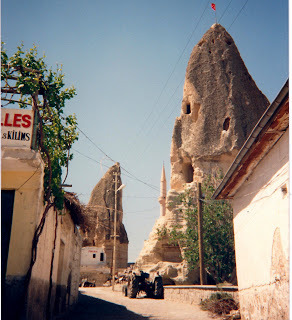
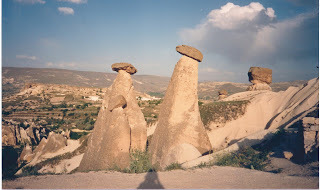
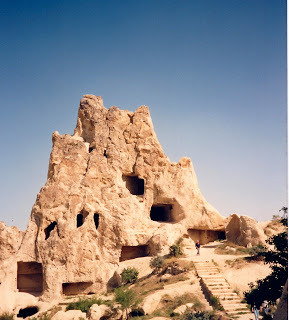
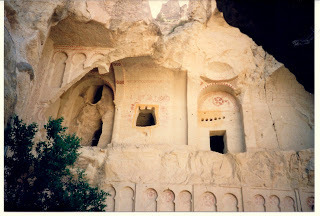
We returned to Bodrum, where a Crusader castle overlooks the harbor. Once the city was the site of one of the Seven Wonders of the World, the Mausoleum of Halicarnassus, long lost to time. My sense of history's weight was sharpened even more when I learned that the Greek, Herodotus, the Western world's first recorded historian, was born there in about 484 BC. His History is unrivaled for his humane view of "barbarians," non-Greeks, and his belief that the gods can warn mortals but do not prevent their follies and the punishment that follows, a concept that seems to have been forgotten.
Our boat owners had a Turkish friend who sold carpets, always a temptation since we both suffer from carpet lust. We were mesmerized and soon succumbed when he dramatically snapped open carpet after carpet, rolling them out one on top of the other for our inspection while we sipped mint tea. His feminine-appearing brother, willowy in shape and missing the ubiquitous thick Turkish mustache, brought out other treasures: a heavy Kurdish copper teapot decorated with round knobs, fancy skewers and embroidered camel harnesses. Without putting up any resistance we bought everything we could carry and stowed our treasures as ship's stores well out of sight of Italian customs officials.
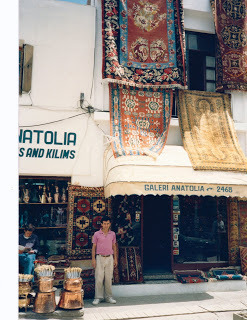
When we walked along the harbor we could see the traditional two-masted wooden sailing boats, gulets, rocking at their moorings while their captains awaited customers for day sails or a week along the inlet-dotted coastline. Some idly smoked on the awning-shaded sterns strewn with carpets and cushions. The red Turkish flags with their white crescent and star flag fluttered in the faint breeze.
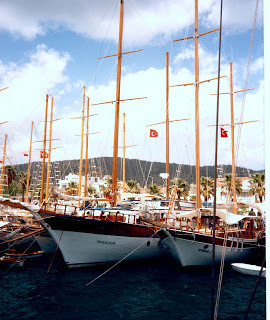
The Virginia was lowered back into the water and it was time to cast off. We slowly sailed toward Italy in choppy waters. Needing to get back to work, I walked the plank at Paros, an island famous for its quarries containing pure white semi-transparent marble used by ancient Greeks for their sculptures. Standing on the dock and watching my shipmates sail off made me feel like I'd been shipwrecked, even though I would fly home the next day from the tiny airfield via Athens. The owner of the small hotel where I stayed kept his eye on me. What he thought I was doing alone was unclear, but whatever he thought it was, he didn't approve, scowling every time he saw me. I was shopping and visiting the Byzantine Church of the Hundred Doors, said to have been founded by that great traveler, Constantine's mother, St. Helena. She stopped on the island on her way to the Holy Land in search of the True Cross, pieces of which are in reliquaries throughout Europe.
Italy's boot appeared far below as I flew back to Rome. Two weeks later Glenn returned home via a rust-bucket Greek ferry from Igoumenitsa to Brindisi and then by overnight train. His watchcap was worn on a rakish angle, he needed a shave and his seabag was filled with dirty laundry. My first mate was home.
Published on March 30, 2012 09:09

